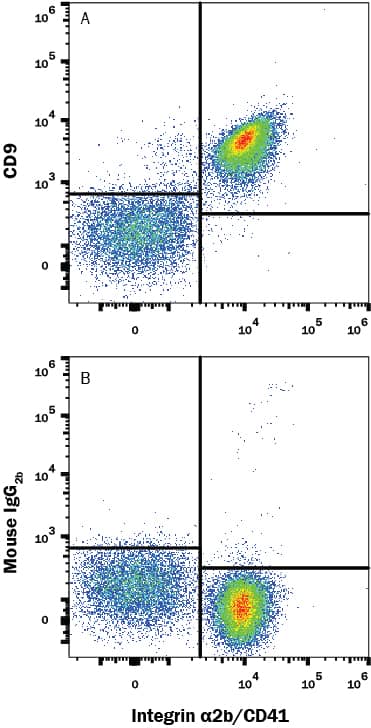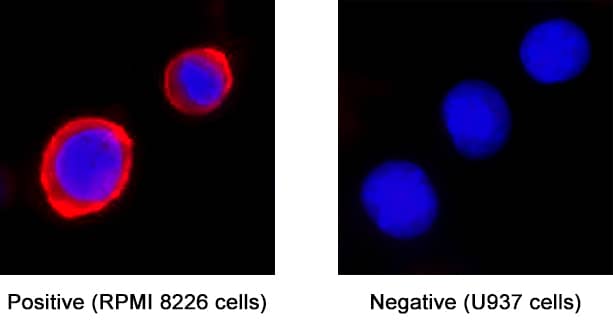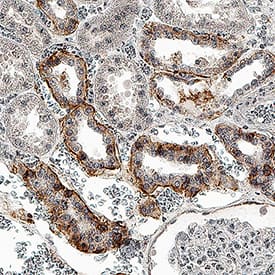Human CD9 Antibody
R&D Systems, part of Bio-Techne | Catalog # MAB25292


Conjugate
Catalog #
Key Product Details
Species Reactivity
Validated:
Human
Cited:
Human
Applications
Validated:
CyTOF-ready, Flow Cytometry, Immunocytochemistry, Immunohistochemistry, Western Blot
Cited:
Immunohistochemistry
Label
Unconjugated
Antibody Source
Monoclonal Mouse IgG2B Clone # 1021007
Product Specifications
Immunogen
Chinese Hamster Ovary cell line, CHO-derived human CD9
Ser112-Ile195
Accession # P21926
Ser112-Ile195
Accession # P21926
Specificity
Detects human CD9 in direct ELISAs.
Clonality
Monoclonal
Host
Mouse
Isotype
IgG2B
Scientific Data Images for Human CD9 Antibody
Detection of Human CD9 by Western Blot.
Western blot shows lysates of TIME human endothelial cell line and human platelets. PVDF membrane was probed with 2 µg/mL of Mouse Anti-Human CD9 Monoclonal Antibody (Catalog # MAB25292) followed by HRP-conjugated Anti-Mouse IgG Secondary Antibody (Catalog # HAF018). A specific band was detected for CD9 at approximately 24 kDa (as indicated). This experiment was conducted under reducing conditions and using Immunoblot Buffer Group 1.Detection of CD9 in Human Platelets by Flow Cytometry.
Human peripheral blood platelets were stained with A) Mouse Anti-Human CD9 Monoclonal Antibody (Catalog # MAB25292) or B) isotype control antibody (Catalog # MAB0041) followed by anti-Mouse IgG PE-conjugated Secondary Antibody (Catalog # F0102B) and Mouse anti-Human Integrin alpha 2b/CD41 APC-conjugated antibody (Catalog # FAB7616A). View our protocol for Staining Membrane-associated Proteins.CD9 in RPMI 8226 Human Cell Line.
CD9 was detected in immersion fixed RPMI 8226 human multiple myeloma cell line (left panel; positive staining) and U937 human histiocytic lymphoma cell line (right panel; negative staining) using Mouse Anti-Human CD9 Monoclonal Antibody (Catalog # MAB25292) at 8 µg/mL for 3 hours at room temperature. Cells were stained using the NorthernLights™ 557-conjugated Anti-Mouse IgG Secondary Antibody (red; Catalog # NL007) and counterstained with DAPI (blue). Specific staining was localized to cell surface . View our protocol for Fluorescent ICC Staining of Cells on Coverslips.Applications for Human CD9 Antibody
Application
Recommended Usage
CyTOF-ready
Ready to be labeled using established conjugation methods. No BSA or other carrier proteins that could interfere with conjugation.
Flow Cytometry
0.25 µg/106 cells
Sample: Human platelets
Sample: Human platelets
Immunocytochemistry
5-25 µg/mL
Sample: Immersion fixed RPMI 8226 human multiple myeloma cell line
Sample: Immersion fixed RPMI 8226 human multiple myeloma cell line
Immunohistochemistry
5-25 µg/mL
Sample: Immersion fixed paraffin-embedded sections of human kidney tissue
Sample: Immersion fixed paraffin-embedded sections of human kidney tissue
Western Blot
2 µg/mL
Sample: TIME human endothelial cell line and Human platelets
Sample: TIME human endothelial cell line and Human platelets
Formulation, Preparation, and Storage
Purification
Protein A or G purified from hybridoma culture supernatant
Reconstitution
Reconstitute at 0.5 mg/mL in sterile PBS. For liquid material, refer to CoA for concentration.
Formulation
Lyophilized from a 0.2 μm filtered solution in PBS with Trehalose. *Small pack size (SP) is supplied either lyophilized or as a 0.2 µm filtered solution in PBS.
Shipping
Lyophilized product is shipped at ambient temperature. Liquid small pack size (-SP) is shipped with polar packs. Upon receipt, store immediately at the temperature recommended below.
Stability & Storage
Use a manual defrost freezer and avoid repeated freeze-thaw cycles.
- 12 months from date of receipt, -20 to -70 °C as supplied.
- 1 month, 2 to 8 °C under sterile conditions after reconstitution.
- 6 months, -20 to -70 °C under sterile conditions after reconstitution.
Background: CD9
References
- Shi, W. et al. (2000) J. Cell Biol. 148:591.
- Hemler, M. (2003) Annu Rev Cell Biol. 19:397.
- Hulme, R. et al. (2014) PLoS One 9:e116289.
- Stipp, C. et al. (2003) Trends Biochem Sci. 28:106.
- Barreiro, O. et al. (2005) Blood 105:2852.
- Ventress, J. et al. (2016) PLoS One 11:e0160387.
- Rubinstein, E. (2011) Biochem Soc Trans. 39:501.
- Anzai, N. et al. (2002) Blood 99:4413.
- Radford, K. et al. (1996) Biochem. Biophys. Res. Commun. 222:13.
- Lozahic, S. et al. (2000) Eur. J. Immunol. 30:900.
- Park, K. et al. (2000) Mol. Hum. Reprod. 6:252.
- Charrin, S. et al. (2001) J. Biol. Chem. 276:14329.
- Tachibana, I. et al. (1997) J. Biol. Chem. 272:29181.
- Zhu, G. et al. (2002) Development 129:1995.
- Green, L. et al. (2011) Infect Immun. 79:2241.
- Powner, D. et al. (2011) Biochem. Soc. Trans. 39:563.
- Detchokul, S. et al. (2014) British Journal of Pharmacology 171:5462.
- Reyes, R. et al. (2018) Front. Immunol. 9:863.
- Slupsky, J. et al. (1989) J Biol chem. 264:12289.
- Ishibashi, T. et al. (2004) J. Neuroscience 24:96.
- Kobayashi, H. et al. (2004) Clin Exp Immunol. 137:101.
Alternate Names
CD9, DRAP-27, MIC3, p24, TSPAN29
Gene Symbol
CD9
UniProt
Additional CD9 Products
Product Documents for Human CD9 Antibody
Product Specific Notices for Human CD9 Antibody
For research use only
